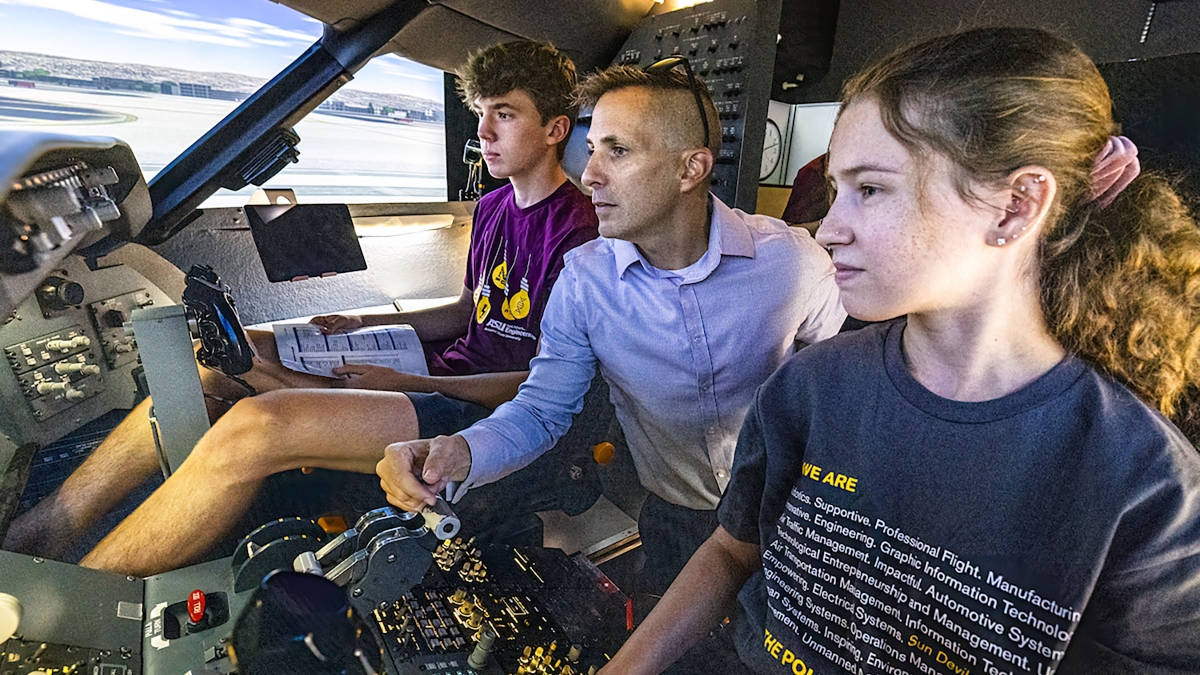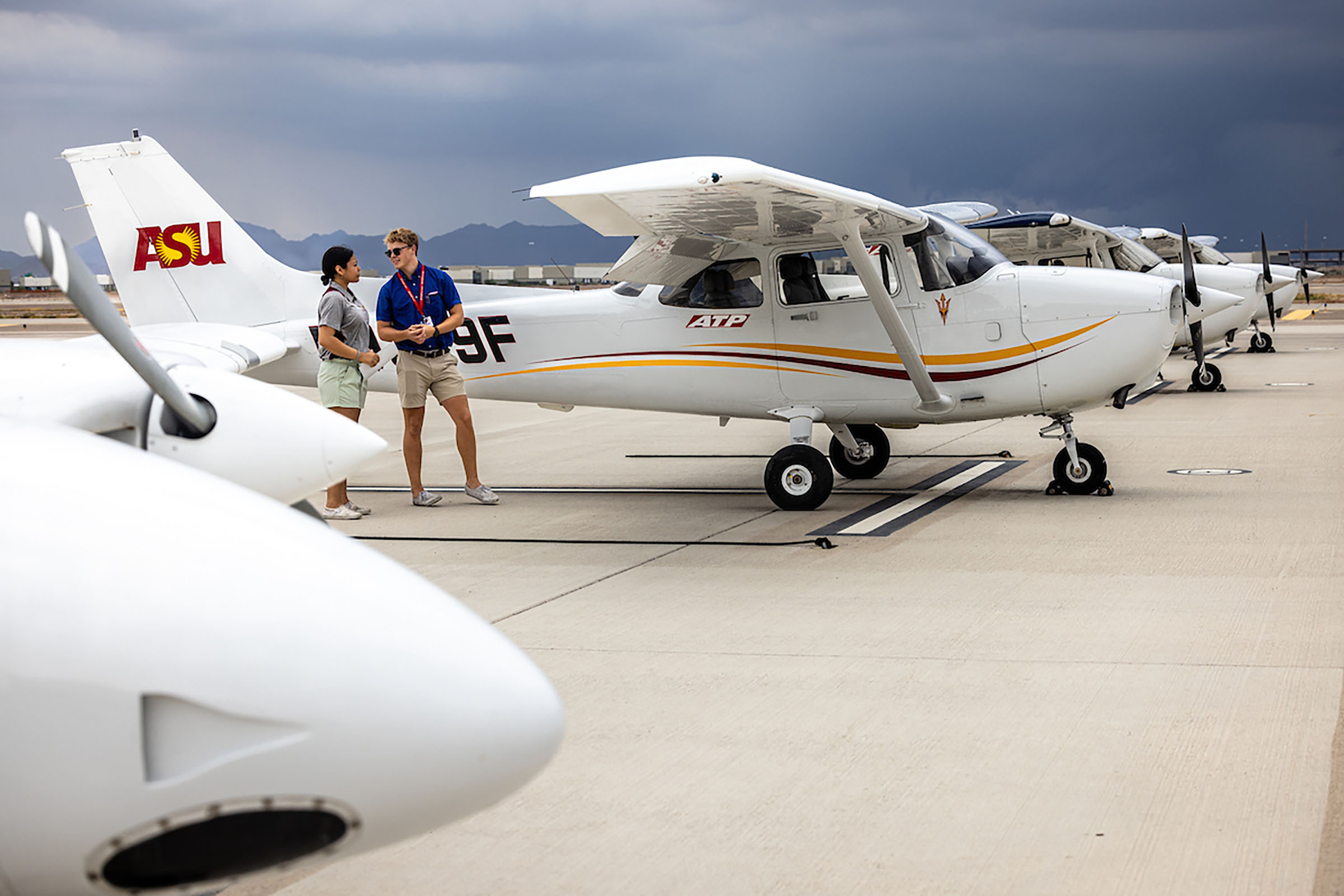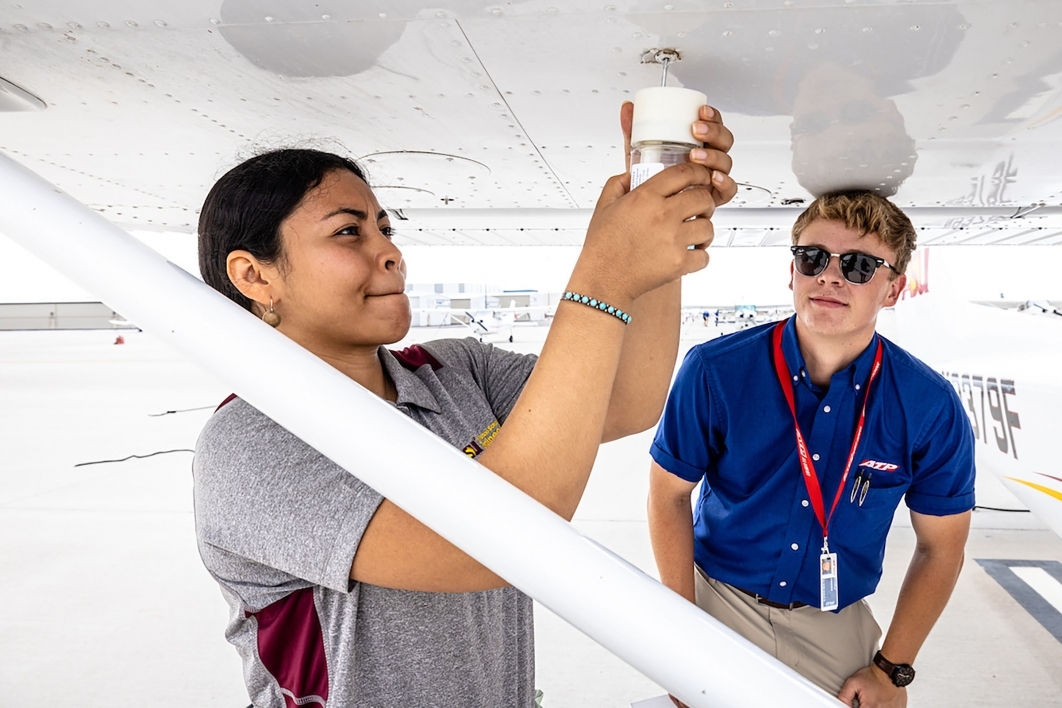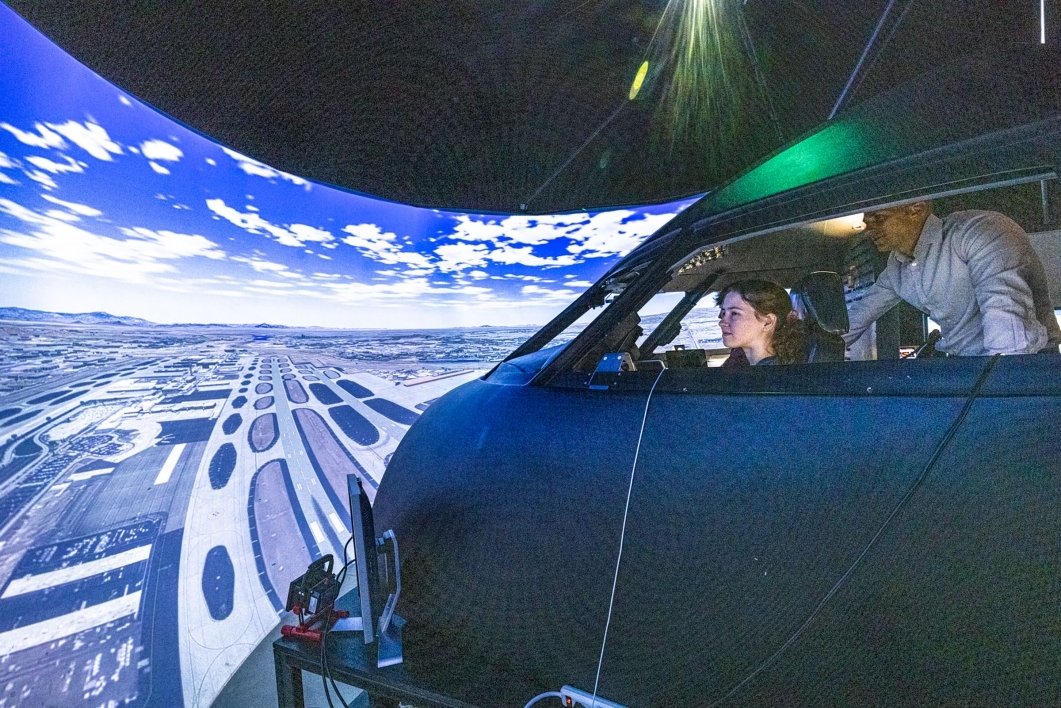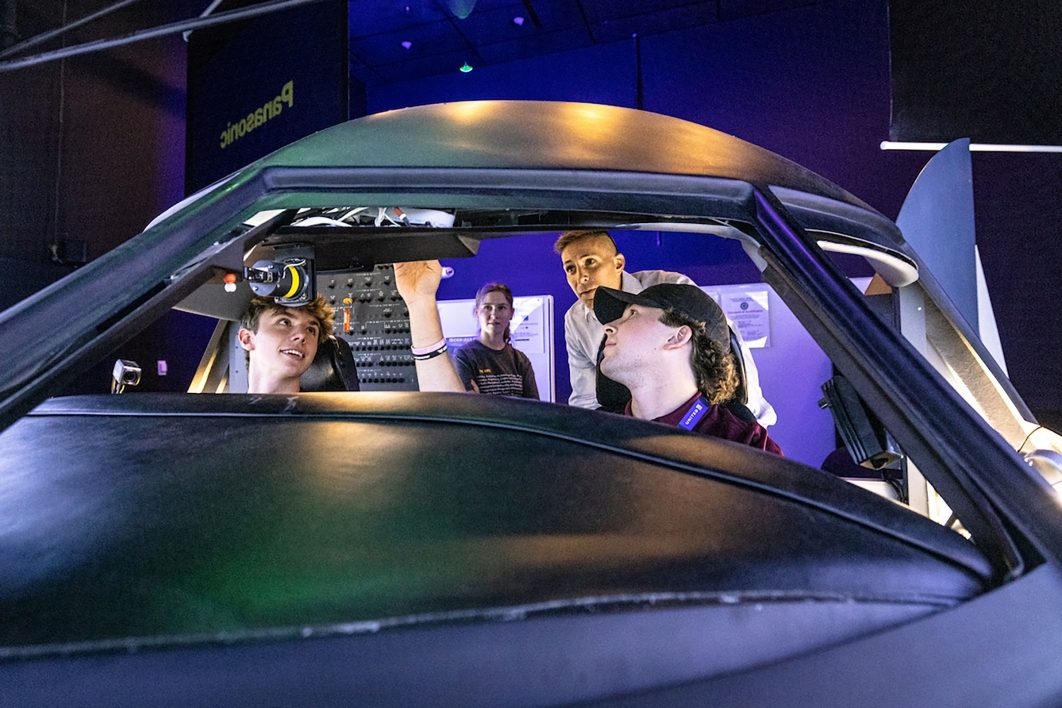Editor’s note: This story is featured in the 2022 year in review.
As the U.S. braces itself for the next round of flight delays, cancellations and lost luggage expected for the Labor Day weekend, Arizona State University is welcoming the incoming class of prospective students to its aviation degree programs, which include professional flight, air traffic management and air transportation management.
COVID-19-triggered repercussions faced by the airline industry extend far beyond a pilot shortage, although that is a key factor. Commercial and cargo air transportation operations are experiencing shortfalls deemed “unacceptable” across all industry job categories last week by Department of Transportation Secretary Pete Buttigieg.
To meet the growing demands for trained industry professionals, ASU’s robust roster of degree programs is sending its grads into the airline industry as pilots, airfield operations specialists, airline dispatchers, flight staffing planners and air traffic controllers. The program welcomed about 100 new students this fall.
“The entire pipeline fell apart,” Ryan Ewing, a 2021 ASU air transportation management graduate, says of the effect COVID-19 had on the industry.
Ewing, who now works out of Dallas in the crew planning department of a major airline, said all of the airlines are dealing with COVID-triggered turbulence.
“First, everyone underestimated the pandemic’s effect on staffing, including the airlines,” Ewing says. “It wasn’t just because pilots were offered early retirement packages, either. Training programs were right-sized to meet demand as capacity was scaled back. Pilots who were on any sort of pandemic-related leave and not necessarily retired had to log a landing every 90 days and/or undergo simulator recertification on their equipment type, among other bottlenecks in the training supply chain.”
Additionally, ground crews, flight crews and staffing planners were put on leave or let go, often not returning to their old positions.
But nothing gets off the ground without the pilots.
Among the perks that make ASU’s aeronautical management technology (professional flight) degree program attractive are its year-round Arizona clear skies, adjacency to Phoenix-Mesa Gateway Airport with employment opportunities that include required flight time through the ATP Flight Training Center, a partnership pipeline to commercial airlines and a bachelor’s degree that makes a pilot more marketable than students of non-degree pilot certificate programs.
Third-year professional flight student and instructor Kolby Feyen gives student Ah’sha Notah a preflight operations check on a Cessna 172R at the ATP flight line at Phoenix-Mesa Gateway Airport on July 28. Photo by Charlie Leight/ASU News
Kolby Feyen, a third-year student in the program, has been working as a flight instructor for ATP since February, flying about 40 hours per month. He works additional hours at ATP between classes, leading ground and simulator sessions with students.
“ASU’s program is clearly mapped out, giving you a specific vision of what you are doing,” says Feyen, who researched pilot degree programs at other universities before choosing ASU. He also cited the program’s flexibility and anticipates graduating after three years with a degree and full certification.
The key for Feyen’s goal of graduating early is completing a range of certification requirements, many of which he has already accomplished, and logging his 1,000 hours of flight time.
“Kolby is completing his certifications as fast as anyone we’ve had in the program,” says Gregory Files, a pilot and Aviation Programs lecturer.
“ASU’s proximity to ATP at Mesa Gateway is a benefit for all of our students, allowing them to log their flight instructor time before, after and between classes by simply going across the street.”
For example, in addition to logging his monthly flight training hours, Feyen works at ATP between classes, leading ground and simulator sessions with students.
Accessibility to the airport is valuable for the transportation management and air traffic control students, as well as aspiring pilots, many of whom find employment and real-world experience in non-flight positions at the airport.
In most pilot certification programs, students are required by the FAA to complete 1,500 hours before getting a commercial flight certificate, according to Files.
“But the degree program enables students to get their commercial certification in 1,000 hours – cutting the flight time and related expenses by one third,” he says.
Another feature that sets ASU apart from other programs is the Canadair Regional Jet (CRJ-200) flight simulator.
“It replicates the make and model of planes flown in regional airlines, which gives student a hands-on experience of what a flight footprint looks like,” Files says.
The 3D experience, complete with cockpit instruments and feedback systems, is the same as a flight experience “without the motion.”
In all, ASU has five different flight simulators, including one that is used for training air traffic controllers in the aeronautical management technology (air traffic management) program, and a high-altitude training chamber that features two hyperbaric chambers.
Marc O’Brien, program chair of aeronautical management technology, cites the program’s long-standing relationships with major airlines, which offer pathways to becoming hired as a pilot.
“Students generally start as first officers for a regional or cargo airline, which fly shorter routes with smaller aircraft,” O’Brien says. “After two or three years they are upgraded to captain at the regional, and with another two or three years in that position, they typically move on to the major airlines.”
Being part of a pathway program at ASU has many benefits for graduates. For example, Envoy Air and Piedmont Air are regional divisions of American Airlines. Endeavor Air is a subsidiary of Delta. SkyWest provides regional service for Delta, United and American Airlines, among others. ASU was one of four universities selected as launch partners with Southwest Airlines’ Destination 225° program.
“Quite a few airlines send representatives to speak to our flight safety classes on Tuesday evenings in the conference room in our Simulator Building,” O’Brien says. “It’s an opportunity for students to ask questions about career paths and for the airlines to get to know our future graduates.
“Our students have many opportunities to navigate airline employment channels. Capstone projects and internships often include working directly with airline personnel to tackle an industry challenge, and many graduates who are now pilots and aviation industry professionals come back and teach classes on a regular basis."
For Ewing, who started his aviation career at Mesa Gateway in airport operations as a second-year student and worked through graduation — later working for a private air shuttle — a huge attraction of ASU’s programs is its sense of community.
“We all knew each other regardless of which degree program we were in, and we remain connected after graduation," Ewing says. "I have a classmate from the same program that I still meet for lunch in Dallas at least once a month.
“A few months ago I was standing in the gate area of a regional flight from Dallas to Phoenix via Durango, Colorado, and saw a pilot who looked familiar. He came up to me and said, ‘Are you Ryan?’ Turns out he graduated a few years ahead of me.
“And the captain on the flight? He was an ASU grad, too.”
Top photo: Second-year aeronautical management technology (professional flight) student Billy Kitchen (left), faculty member Greg Files and recent graduate Taylor Hayslett (right) go through pre-flight checks in the CRJ 200 cockpit simulator on ASU’s Polytechnic campus on July 28. The FAA accredited program has more than 100 new students for fall 2022. Photo by Charlie Leight/ASU News
More Science and technology

Compact X-ray laser lab aims to reveal deep secrets of life, matter and energy
X-rays allow us to view inside the human body to diagnose broken bones and other hidden problems. More recent X-ray advances are making it possible to see events at the scale of atoms and molecules,…

Apollo lunar samples enable ASU researcher to pinpoint moon’s crystallization timeline
A team of researchers, including Arizona State University geochemist Melanie Barboni, in collaboration with scientists from The University of Chicago, have made a new discovery about the history of…

NASA launches space telescope to chart the sky and millions of galaxies
California’s Vandenberg Space Force Base was the site for Tuesday’s 8:10 p.m. launch of the NASA SPHEREx mission aboard a SpaceX Falcon 9 rocket.The SPHEREx (Spectro-Photometer for the History of the…


